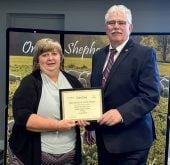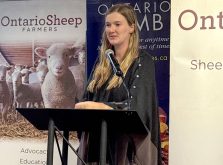A 2019 study has found that there are limited ways to control ravens which prey on lambs.
Jillian Craig, small ruminant specialist with OMAFRA, undertook the study last summer, to better understand raven predation within Ontario.
The three-part project included a province-wide survey to collect information on the magnitude of raven predation within Ontario sheep operations. Part two included non-lethal raven deterrents on sheep farms to collect data on their effectiveness. The third part was mapping predation throughout the Ontario Wildlife Damage Compensation Program.
Why it matters: Raven predation can mean injured or dead lambs, a significant cost to farmers, and an animal welfare concern.
Read Also

Canada seventh-most influential country on agri-food
Report from Dalhousie University and MNP shows Canada ranks seventh among G20 countries on agri-food influence.
Ravens are very smart predators. Once a raven learns how to kill or injure a lamb, it’s very difficult to get them to stop, and they will train other ravens. If farmers have a raven problem, they need to deal with it as soon as possible.
“There’s a lot of producers in Northern Ontario who say it’s been a problem for quite some time, but certainly in eastern southern Ontario it’s sort of a newer problem,” says Craig.
The survey showed that 2018 had a spike in avian predation.
“This was mainly due to a pasture lambing that experienced big losses. The ravens had learned how to kill lambs and injure lambs successfully, so they experienced massive problems,” says Craig.
The survey was completed across 24 farms in Ontario, with an average flock size of 480 ewes.
Sixteen of the farms had experienced raven predation with seven having observed ravens on their farms and only a select few having past issues.
Most of the injuries on these farms were shown to occur in the pasture, followed by the barnyard and within the barn.
It was found that the pecking of eyes and rectum were the most common methods of injury and pre-weaned lambs were the main targets.
The deterrent part of the trial looked at three main approaches: decoys, raven kite and scare eye balloons.
“I wanted low cost alternatives that a farmer could purchase rather than the big thousand dollar things that may or may not work,” said Craig.
Although there was a decrease in the rate of kills per day when deterrents were used, analysis showed no significant difference in the raven kills per day with a p value of 0.1537.
“In general, the raven kill per day did decrease with the deterrents. However, the change was not significant. In order to be significant it needs a p value of 0.05 or lower – but there are some influencing factors.”
Those include the sample size and timing the deterrents.
“Unequal timings of deterrent use – that was mainly because we have some farms starting lambing earlier, some farms starting lambing later, some farms we had to bring on later because they hadn’t had problems and then they were having problems. That’s really a big factor there as well.”
Non-lethal deterrents are advised when raven predation is a problem but they should be used only for short periods so the birds do not become accustomed to them.
Other suggestions to discourage ravens include collection of afterbirth, quick disposal of dead stock and elimination of easy roosting spots around the property.
“Disposing of that stuff is really critical,” said Craig. “This is what a lot of farmers had mentioned and maybe why they had started having problems. Also, eliminating dead trees or easy roosting spots around the pastures or barns.”
Craig is continuing to track raven predation with a 2020 raven deterrent summer project, but it may be pushed to a later date with COVID-19.
Those experiencing raven predation who want to get involved in the study can email [email protected].















